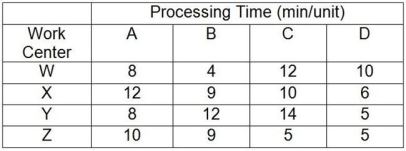Multiple Choice
Table 5.2
A company makes four products that have the following characteristics: Product A sells for $75 but needs $20 of materials and $20 of labor to produce; Product B sells for $90 but needs $45 of materials and $20 of labor to produce; Product C sells for $110 but needs $50 of materials and $30 of labor to produce; Product D sells for $135 but needs $75 of materials and $40 of labor to produce. The processing requirements for each product on each of the four machines are shown in the table.

Work centers W, X, Y, and Z are available for 40 hours per week and have no setup time when switching between products. Market demand is 50 As, 60 Bs, 70 Cs, and 80 Ds per week. In the questions that follow, the traditional method refers to maximizing the contribution margin per unit for each product, and the bottleneck method refers to maximizing the contribution margin per minute at the bottleneck for each product.
-Use the information in Table 5.2. Using the traditional method, what is the profit if the company manufactures the optimal product mix (consider variable costs only-overhead is not included in this profit calculation) ?
A) less than or equal to $6,500
B) greater than $6,500 but less than or equal to $6,700
C) greater than $6,700 but less than or equal to $6,900
D) greater than $6,900
Correct Answer:

Verified
Correct Answer:
Verified
Q27: Consider the following production process. It is
Q28: Which of the following statements concerning line
Q29: To generate the maximum output, the cycle
Q30: Figure 5.3<br> <img src="https://d2lvgg3v3hfg70.cloudfront.net/TB1252/.jpg" alt="Figure 5.3
Q31: Regardless of the number of tasks or
Q33: The second step in Theory of Constraints
Q34: Table 5.4<br>The Superior Management Company assembles muffalettas
Q35: A bottleneck process has the lowest capacity
Q36: A firm's actual throughput and profit depend
Q37: Table 5.1<br>A company makes four products that